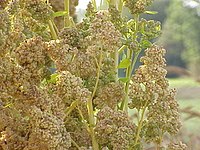
Photo from wikipedia
BACKGROUND β-N-oxalyl-L-α, β-diaminopropionic acid (β-ODAP) is a physiological indicator in response to drying soil. However, how abscisic acid (ABA) modulates β-ODAP accumulation and its related agronomic characteristics in drought stressed… Click to show full abstract
BACKGROUND β-N-oxalyl-L-α, β-diaminopropionic acid (β-ODAP) is a physiological indicator in response to drying soil. However, how abscisic acid (ABA) modulates β-ODAP accumulation and its related agronomic characteristics in drought stressed grass pea (Lathyrus sativus L.) continue to be unclear. The present study was conducted to evaluate the effects of ABA addition on drought tolerance, agronomic characteristics, andβ-ODAP content in grass pea under drought stress. RESULTS Exogenous ABA significantly promoted ABA levels by 19.3% and 18.3% under moderate and severe drought stress, respectively, compared with CK (without ABA treatment). ABA addition activated earlier trigger of non-hydraulic root-sourced signal at 69.1% field capacity (FC) (65.5% FC in CK) and accordingly prolonged its operation period to 45.6% FC (49.0% FC in CK). This phenomenon was mechanically associated with the physiological mediation of ABA, where its addition significantly promoted the activities of leaf SOD, CAT, and POD enzymes and the biosynthesis of leaf proline, simultaneously lowering the accumulation of MDA and hydrogen peroxide under moderate and severe stresses. Interestingly, ABA application significantly increased seed β-ODAP content by 21.7% and 21.3% under moderate and severe drought stress, but did not change leaf β-ODAP content. Furthermore, ABA application produced similar shoot biomass and grain yield as control groups. CONCLUSIONS Exogenous ABA improved the drought adaptability of grass pea, and promoted the synthesis of β-ODAP in seeds but not in leaves. Our findings provide novel insight into the agronomic role of ABA in relation to β-ODAP enrichment in grass pea subjected to drought stress. This article is protected by copyright. All rights reserved.
Journal Title: Journal of the science of food and agriculture
Year Published: 2021
Link to full text (if available)
Share on Social Media: Sign Up to like & get
recommendations!